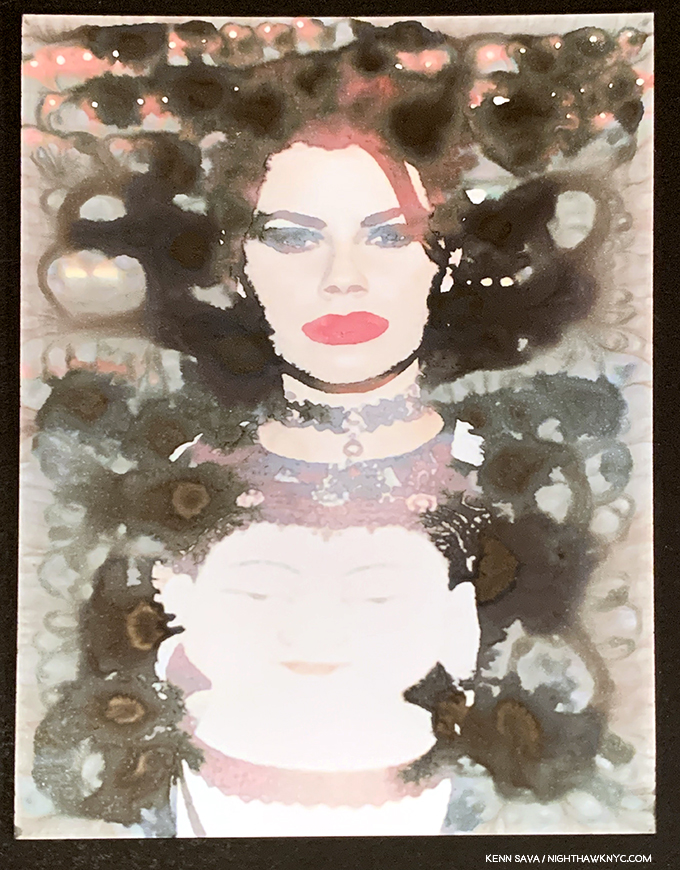Written & Photographed by Kenn Sava.
Works by Fred Cray Photographed by Fred Cray.
Maybe this has happened to you?
There you are, minding your own business, possibly looking through a book in a bookstore.
And all of a sudden, you see this-
“What’s this Photo doing in here? Is this part of the book? Did someone vandalize John Divola’s “Vandalism?,” I wondered aloud? No answer.
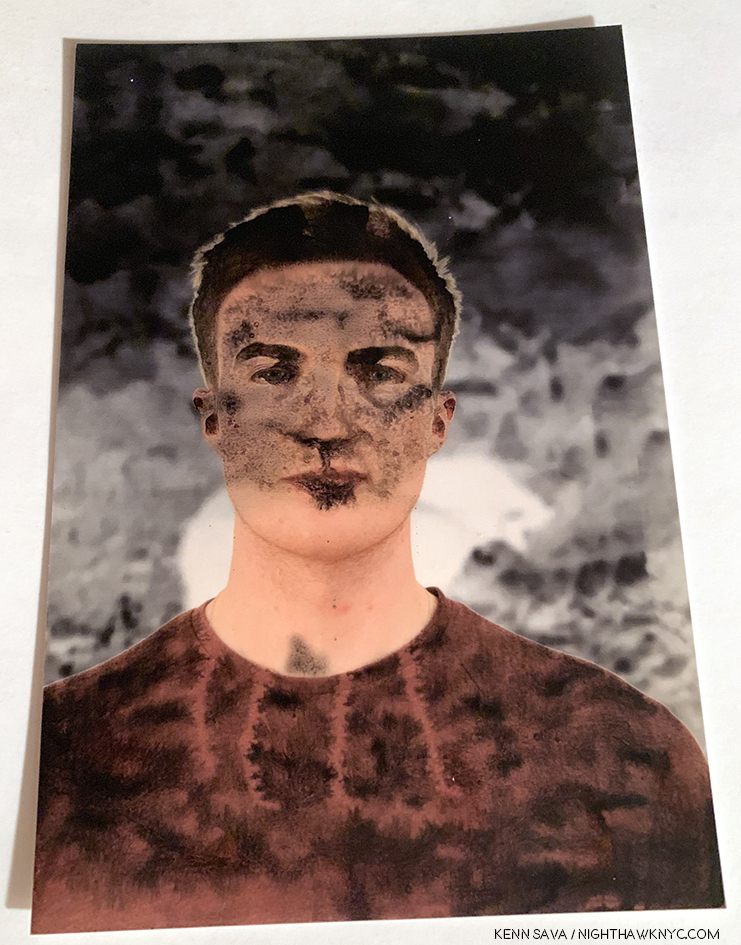
Close up of the inserted 4 x 6 inch Photo.
Turning it over, I see this on the back-
Is this a “Unique Photo” of someone named Fred Cray?
Then, some months later, it happened to me again. I was looking through another PhotoBook, this one by Doug & Mike Starns, and whamo…
Seeing the name “Fred Cray” printed on the back both times it dawned on me that- no, it’s not part of the book. Fred Cray isn’t the author of either book I was perusing, the Artist either was about, and this time it’s not a portrait. The Photo must have come from elsewhere. Fred Cray is ANOTHER Artist- the Artist creating these “Unique Photos.” Maybe this Fred Cray, himself, put it in here? And, there’s more. Both times, the particular image being placed in this spot in the book spoke to me. I wound up purchasing both books because I wanted to keep that serendipitous synchronicity intact. I got it! He’s an Artist working with a publisher to help them sell books! Naw…
Having this happen to me a few times, the name Fred Cray was now somewhat known to me, though the man and his work remained an utter mystery. At first, like most others who accidentally come across his work, I didn’t know what to make of it. An isolated image here and there? It’s impossible to get a sense of anyone’s work, as you see. Then, by chance, I happened to spot “Fred Cray” on the list of my readers, so I chanced writing to him to ask if he was “THE Fred Cray?” He replied that indeed he was. Shortly after, I discovered that he self-publishes PhotoBooks of his work. Once I began to see his PhotoBooks, I got a sense of his work, and I got interested.
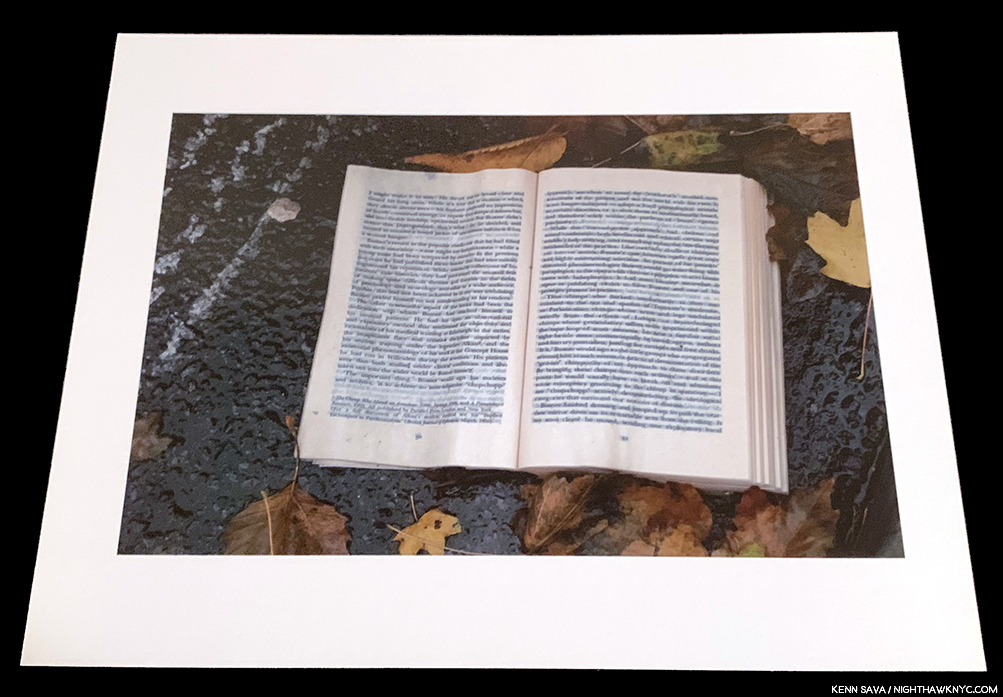
An unusual Unique Photograph by Fred Cray included in his book Conversations. Unusual because it’s a larger 6 x 9 size (4 x 6 being his “standard” size) and because it’s signed on the verso.
I met him in person a few months later at a book signing for another Photographer we’re both interested in, and as we spoke, I realized that he and I had probably been in the same gallery, museum or book store, countless times before. He’s as obsessed by Art & PhotoBooks as I am, and his taste is, unsurprisingly, from looking at his work, wide ranging. I find all of this interesting and a bit unusual. Many Artists, Photographers & Musicians I know don’t want to know what others are doing. They either don’t want to be influenced or are too focused on what they themselves are doing. Not Fred. Every time I have the pleasure of speaking with him or conversing with him by email, he’s up on whatever is going on at that moment. This show or that? The odds are he’s seen it, including a good many out of town, which I don’t get to. Chaos at the Whitney Biennial? He had just been there to see Nicole Eisenman’s work since it might have been leaving, though the announcement it might had only come a day or so before1 And, he just got back from over a month in Spain, where he “vandalized” (soft smile) both parks and the Prado Museum, blanketing the town with Unique Photographs, including some he hung in trees, he told me, with an impish grin. I would have loved to see a “candid camera” catching the reactions of those who discovered them. Taking stock of all of this, I wondered-
WHO gives away one of a kind works of Art?
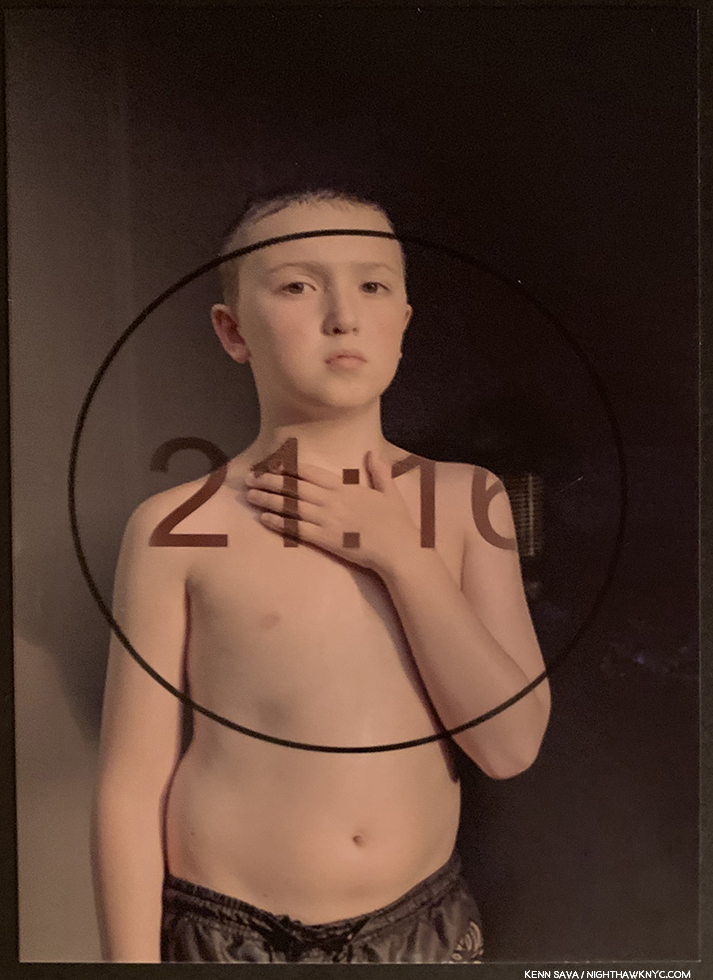
A haunting Unique Photograph included with a copy of his book titled #. Being unique, need I say the Unique Photos included vary from copy to copy of his books?
As I began to get a sense of what he was doing, I mentioned to Fred that I had decided to write about him and his work. His first, and only, request was that I didn’t ask to follow him around as he distributes his Unique Photographs. The The New York Times had already done that. I can understand that, and I apologize, to him for leading with the Unique Photographs here at all. The Times reported that Fred had left some 30,000 Unique Photographs everywhere he’s been since about 2008. Has anyone in Art ever given away 30,000 unique works of Art? That means A LOT of people, like myself, who had never heard of him are discovering him and his work the same way I did- through finding those works by chance.
The earliest work I saw during my visit to Fred Cray’s studio- this Travel Diary, from the 1990s, above, when he was shooting film and black & white at that.Shortly after he returned from Spain for his annual out of the country summer trip, he invited me out to visit his studio in Brooklyn. Over the 4 hours we spent together, he told me that he has now distributed over 43,300 Unique Photos2! That, by itself, makes Fred Cray something of an NYC Urban Legend, but, as I found out, it’s really only the beginning of the story. Even after returning that night from seeing box after box of gorgeous full size (often very large), original works, the vast majority of them created in an edition of 1, i.e. unique, I realized that though we went through six or seven of the large boxes he had in his studio, he only showed me work dating back to 2017. Fred has been creating work since 1990!
Frankly, I was shocked to see that everything he showed me was very good work, and much of it terrific in my opinion, all of it characterized by an exceptionally high consistency. Not only is Fred Cray one of the most interesting Artists using Photography working today, he’s, also, a very good editor. As we spoke, I discovered that anything that didn’t make his grade wasn’t saved. You see this very tight editing in his PhotoBooks, but when you’re looking through recent work in an artist’s studio, I generally expect to see some “work prints,” “pieces in progress,” or abandoned ideas. Not one.
Yet? There’s more. As I got lost looking at work after work being passed in front of me for a few moments each, during these few hours, Fred was talking non-stop about the processes (plural) he used on these prints. At first I was stopped by terms like “Reprinted,” “Dissolve,” “Fragments,” and others, and when I backtracked and said, “What?,” I discovered he invented, and named, each process to realize his vision and create the numerous series his work is often grouped in to this point, as well as the multiple projects he’s currently working on. I counted at least 4 of these in various stages of completion. To go along with this, everywhere around the fastidiously neat and carefully organized studio are stack after stack of 4 x 6 inch Photographs- the size of the Unique Photos he distributes. Each pile was 5 to 6 inches tall. So? You tell me- how many photos would be in a 6 inch stack? Multiply that by at least 10 stacks. That’s about how many Unique Photographs Fred Cray had in his working piles. Maybe 5,000? Remember- each one is a one of a kind work of Art. That means it only exists that way on that print. Once he moves on and the files have been removed from his computer, he can’t duplicate it.
In 2019, many Photographers rely on their computers as the focus (sorry) of their workflow, their process, and indeed their work. Though Fred has couple of computers in his studio, I have no idea if they were even on. He never once went to one. He works off what he prints. Like everything else the man does- in his own way.
He’ll make these prints, then spread them out on his work table to study and assess them. From there, he’ll decide what the next step is. Does the print in question get modified? If so, how? Though he attended Painting classes at Yale, a survey of the techniques Fred uses to modify a print would be a study in an of itself, if not a book. Does he put it back in the printer(! Decidedly NOT recommended by most printer manufacturers I know of) and “reprint” it with another image or partial image over it?! Or, maybe he’ll modify it using the spectacular, and spectacularly fragile “dissolve” process he invented that he used to create the works in his 2017 show of the same name at Brooklyn’s renowned Janet Borden Gallery, his dealer since 1998. Some of this series may be seen in his book of the same name (the first 40 copies of which comes with an actual unique print from the Dissolve series).
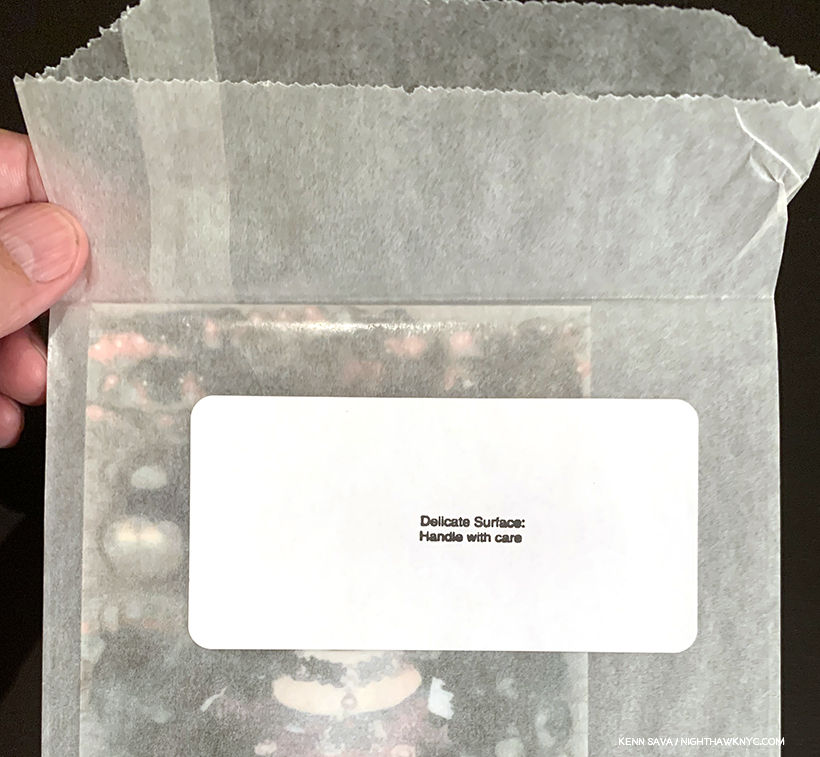
I’ve never seen a Photograph that comes with its own warning label before. The glassine envelope the Unique Dissolve Photograph included with this copy of the book Dissolve.
To make these works, as I understand it, Fred prints the images on a surface that repels ink! After he does, the image, such as it is, or was, “dissolves” in front of his eyes, morphing into something else, possibly something useless, in moments. The Artist halts the process at the moment that speaks to him, freezing the image in the delicate and fragile state it every bit appears to be in from just looking at it.
By now, a pattern was emerging here.
Perhaps you, too, see a strong Buddhist influence is all of this (even before that last picture)- The giving away of one of a kind Art works reminds me of the Sand Mandalas created by Tibetan Monks over, in some cases, long days of arduous effort, only to then sweep them away after a ceremony. Impermanence is a core value in Fred Cray’s work- and it permeates his approach was from giving away original unique Art right down to the techniques he’s invented, like his “Dissolve” process, and his new, “Fragments” Series, he gave me a sneak peak at.
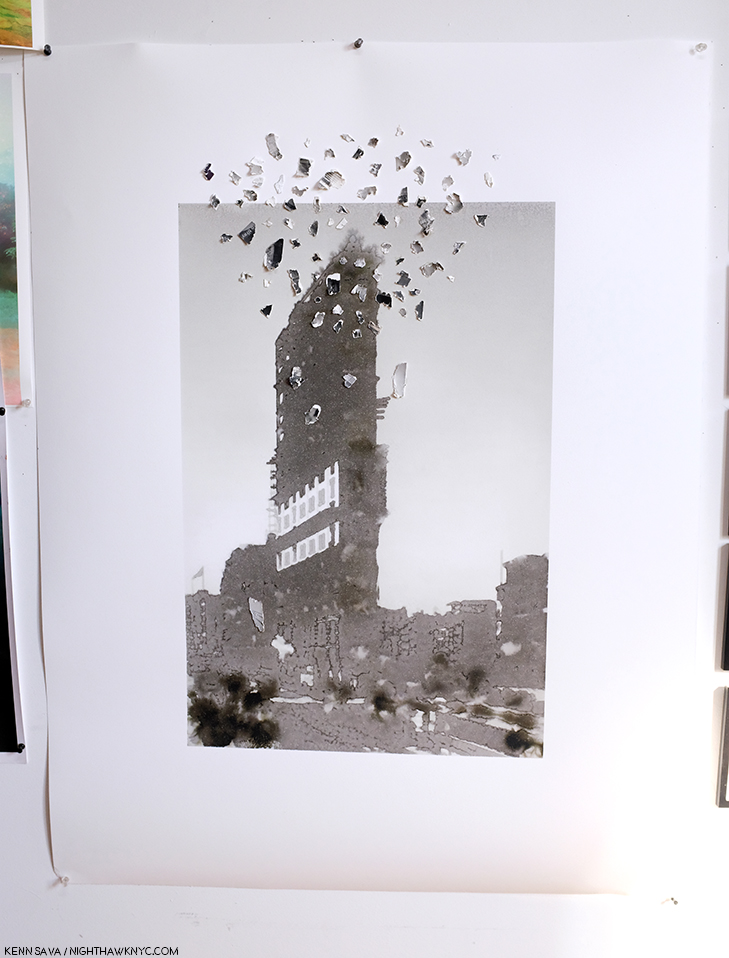
A haunting image of The Flatiron Building from the “Dissolve” series now appears in this work from Fred’s new “Fragments” series.
No need to get the science books out to understand this one. (Phew…My science book section totals zero. Unless David Hockney’s Secret Knowledge counts as science.) One day, Fred came home to discover his cats had decided to show him their “editing skills.” They had chewed up some of his work prints. Undaunted, and taking a philosophical approach, he decided to put them to work. He took the “scraps” they had left behind and mounted them on other images. Voila, “Fragments.” A large print of the Flatiron Building hung near his door and captivated me the moment I walked into his studio and saw it. Sure enough, a work from “Fragments.” Often, when he “reprints” a Photograph, or creates a work in his “Dissolve” series, he’s not sure, (exactly, or even at all) what he’ll get. In that regard, there’s a Zen element to his work as well.
And? To my shock (and the horror of the Art history lover in me), it turns out the impermanent nature of Fred’s work extends much further.
Over the course of my 2 1/2 year “deep dive” into the world of Modern & Contemporary Photography (think post-Robert Frank’s The Americans), it’s become apparent to me that so-called Fine Art Photography is something of a wild west with no rules. Unlike Painting, a Photograph, in theory, can be reprinted ad-infinitum, indefinitely, for as long as the negative or the digital file exists. That some Photographers have taken to reissuing their work in second editions, something of a strict no-no to this point, and any number of estates have brought in others to print their Artist’s work (which, frankly, raises questions for me), says to me that it can be pretty scary to buy Photography for the big money being asked for it, and all Art, in these days at the top of an Art Market that hasn’t seen a price correction, or worse, in decades. Therefore, it seems to me that, as a by-product of his philosophical approach, Fred Cray is something of a “Photography collector’s dream.” Once Fred is finished working on a body of work, he removes it from his computer.
He keeps no archive!
Like that Unique Photo you found? Keep it safe because it cannot be duplicated or replaced. In this sense, his work is like that of a Painter’s. “Unique” means unique. Fred does create some editions as well, and his PhotoBooks are published in small editions of between 5 and 200 copies each. So fascinated by the PhotoBooks Fred has created over the past decade, I am devoting an entire piece, a Part 2, to look at them.
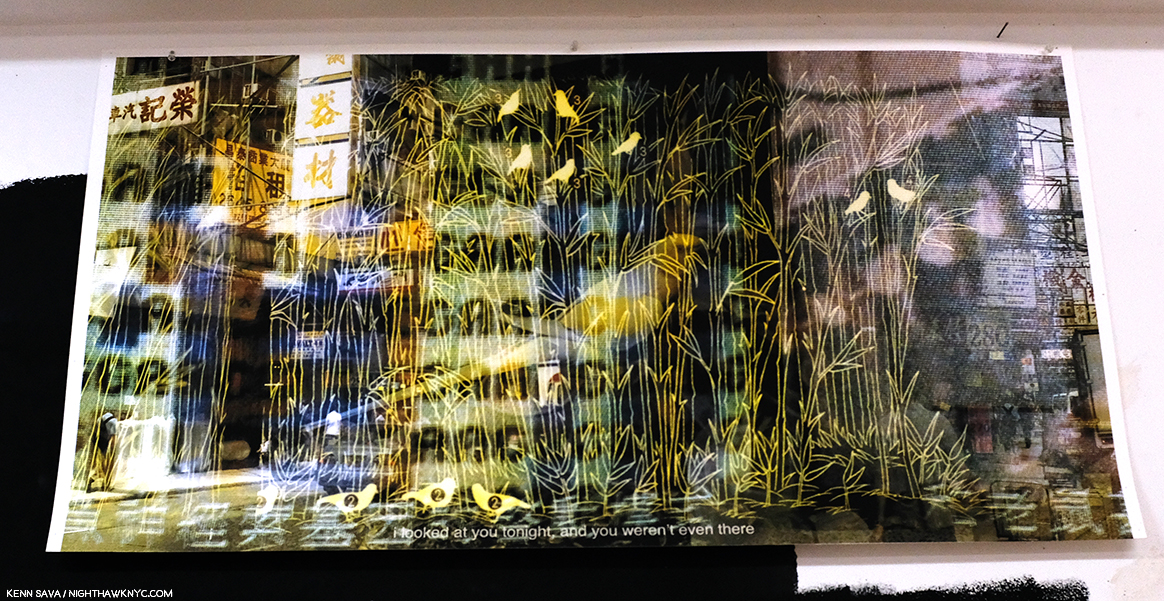
I looked at you tonite and you weren’t even there. An deeply personal work using found words in a large, editioned size, seen on the wall of his studio.
When I queried him on all of this (I don’t think he noticed my mouth opened as I grocked his replies), I asked him about the 4 x 6 Unique Photos he hands out- “Don’t you have an archive of them? I’d love to be able to look through them and see them all.” He picked up a half sheet of torn paper next to his work table. On it were columns of numbers going down, all but the last of which had been crossed out.
That’s it.
The sheet simply records the last number he had handwritten on a print so he would know which number to start with next time. When he reaches “9999,” he starts again at “1.” I’ll wait until you get up off the floor.
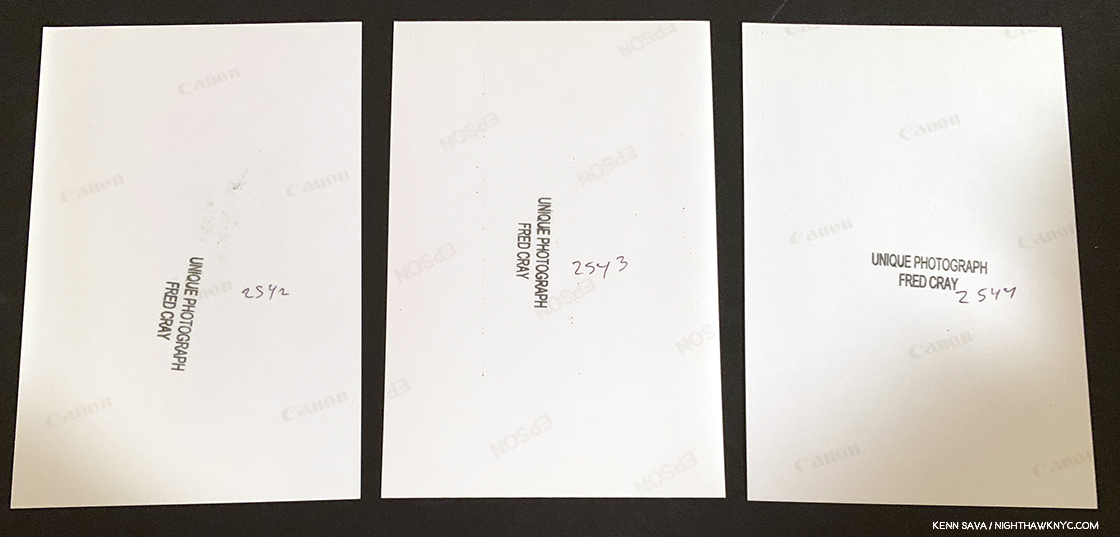
The universe is random. These 3 Unique Photographs that came with a copy of Changing of the Guard have consecutive numbers, something I haven’t seen before.
That means there are now 5 with the number “1” on the back, etc., but no way of telling which one is the “REAL” “1,” and which is ten thousand and “1.” No record. No hermetically sealed vault of originals. Just what you hold in your hand. On the subject, he told me- “I keep lots of images I’ve taken (or found) over the years hoping that they’ll resonate in new ways when I go back through them. But every time I go through old files I try to delete a bunch. If I can find a way to remake an image in a new way I have no problem doing that. I wouldn’t want to go back and make the print as it was perhaps made before. But you are correct in saying I don’t keep an archive of the Unique Photographs that have gone out.” That sound you’re hearing are the voices of all the future Art Historians who will be fascinated by Fred’s work saying “Goodbye” to their dreams of trying to compile a “catalogue raisonne” of his Unique Photographs.
On August 22nd, Fred told me he had just completed his latest PhotoBook, Splendor Solis. After working on a series on the Sun for years, taking Photos of it in various ways, he finally came across the right means of collecting and displaying them. One day on 14th Street, he discovered a book he felt was the perfect instrument. He proceeded to buy up 35 copies of it, which were stacked on the floor next to his work table when I visited him in July. On the table, I noticed an array of rubber stamps and some watercolors. He explained to me that he’s going through the books one copy at a time, adding about 15 Unique Photographs (yes, different in each copy of the book) to 3 recurring Photos. Then, he’s customizing pages with a variety of media- the aforementioned rubber stamps, watercolors, etc. The project is loosely based on alchemy. As I looked at what he was showing me, Bruce Conner came to mind, briefly. But, there really isn’t anyone else I can compare Fred to- not Cristina de Middel. Not Ray Johnson (who may be closest in some ways). Not Henry Darger. Not Jim Dine, Gilbert and George, or Vik Muniz. His work is, also, unlike Robert Rauschenberg’s, not an easy thing to do.
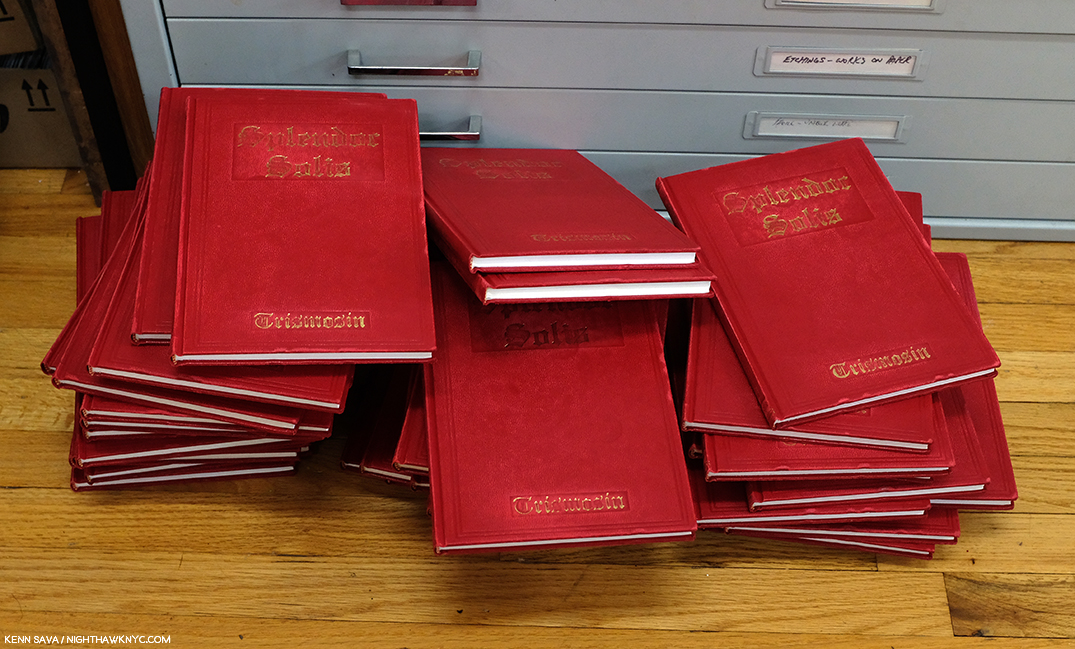
Impermanence incarnate. The complete edition of Splendor Solis. 31 copies, plus 5 Artist’s Proofs. Now that he’s finished them, there’s a very good chance they will never be seen together again.
Earlier, I mentioned the Whitney Biennial, in progress as I speak until late September. (My look at the 2017 Biennial is here.) Once again, it leaves me with mixed feelings. On the one hand, it’s so hard for an Artist in this country to receive any recognition for their work, it’s good such things exist. I’m not taking anything away from anyone included when I say that each time the list is announced, my thoughts turn to all the great Artists who get left out.
Like Fred Cray.
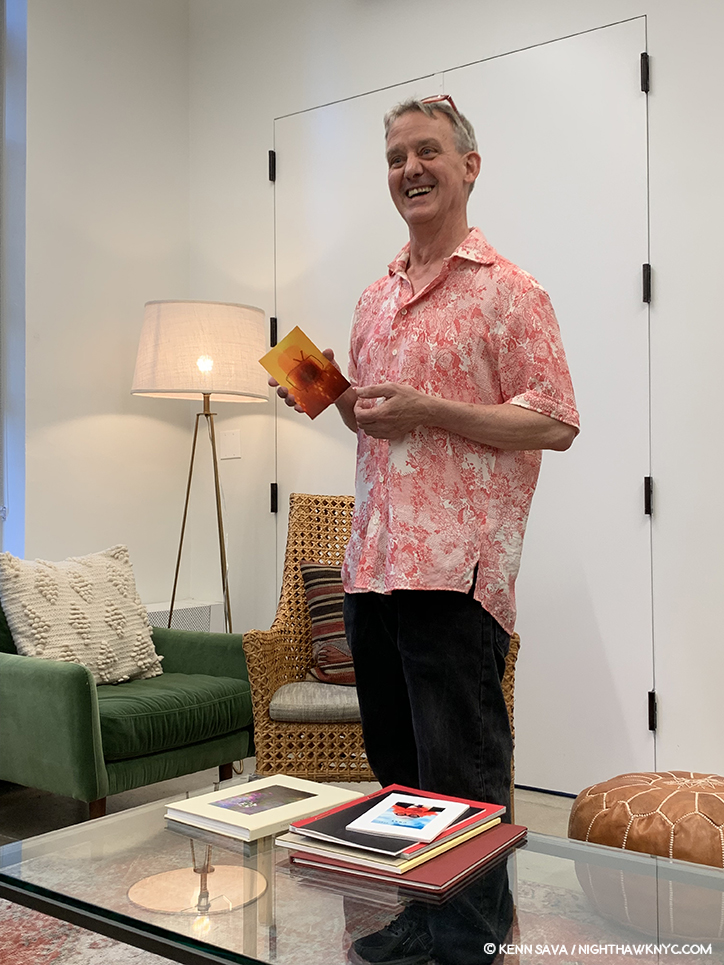
The Artist holds one of his Unique Photographs with a selection of his books in front of him during an Artists’s Talk at a 10 x 10 Books Salon, May 16, 2019.
I told him this, and his reply caught me off guard. “Wouldn’t it be great if they had included a great Artist, like David Hammons?”
Undaunted, I’ll up the ante. Having had the chance to look closely at his work, albeit only from the past 3 years, (Fred, a 2003 Guggenheim Fellow, has been creating for almost 30 years now), I believe his work is going to receive more and more attention in the future- and in the near future, from collectors, and particularly from museums & their curators.
Why do I feel this way? Because, along with being continually innovative, the bottom line for me is his work is that good. And? Among all the Artists & Photographers known to me, there’s no one like Fred Cray. He’s unique.
-Soundtrack for this Post is “Changes” by David Bowie from his classic 1971 album Hunky Dory–
“I watch the ripples change their size
But never leave the stream
Of warm impermanence and
So the days float through my eyes
But still the days seem the same”*
My thanks to Fred Cray.
This is Part 1 of my 2 part look at the work of Fred Cray. Part 2 is a look at the PhotoBooks Fred has published over the past decade and may be seen immediately following below this, or here.
NighthawkNYC.com has been entirely self-funded & ad-free for over 7 1/2 years, during which almost 300 full length pieces have been published! If you’ve found it worthwhile, PLEASE donate to allow me to continue below. Thank you, Kenn.
You can also support it by buying Art, Art & Photography books from my collection! Art & Books may be found here.
Written & photographed by Kenn Sava for nighthawknyc.com unless otherwise credited. To send comments, thoughts, feedback or propositions click here. Click the white box on the upper right for the archives or to search them. Subscribe to be notified of new Posts below. Your information will be used for no other purpose.
- The situation seems to have been resolved in the following week, and the works will remain in the Whitney Biennial, as far as I know. ↩
- Fred added, “Early on I didn’t number the photographs, so there are probably an additional 1,500 un-numbered. I started numbering them to reiterate the unique aspect of the photographs.” ↩











